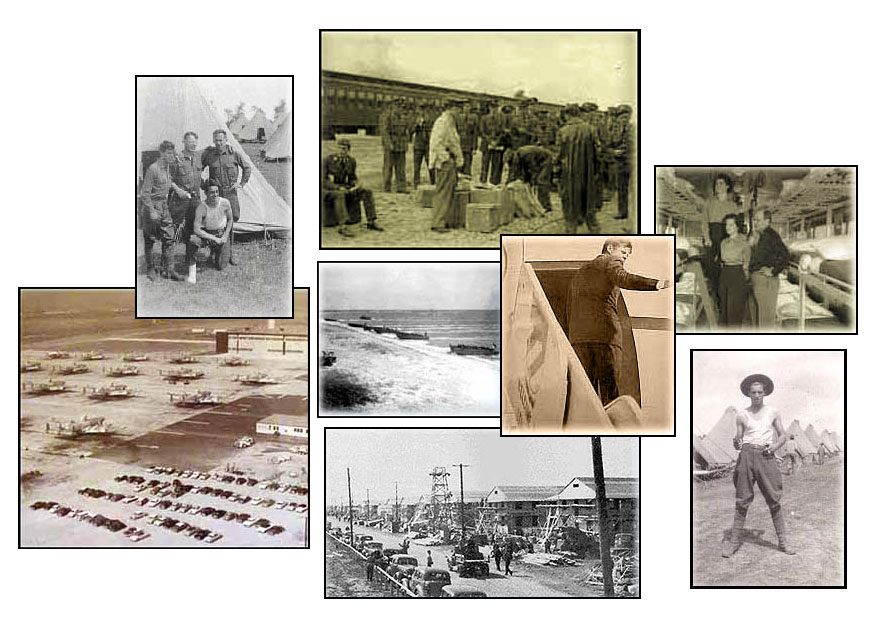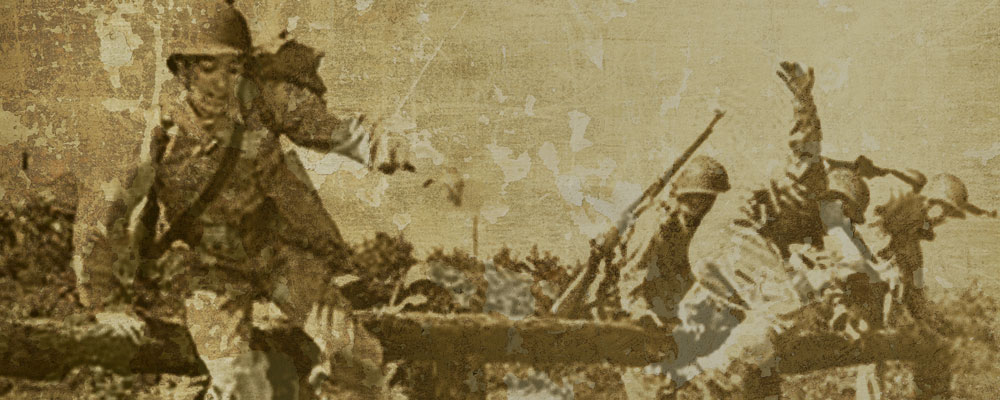The history of Massachusetts National Guard training on Upper Cape Cod extends back to 1908, when Soldiers conducted weekend and annual training in the woods to the south and west of the present-day Massachusetts Military Reservation. In 1931, the adjutant general of Massachusetts appointed a board of six Army National Guard officers to find a new campsite, as Camp Devens was deemed too small for required training. In 1933, Cape Cod was initially identified as a viable area for the new camp, to mixed reaction from the local communities. Feasibility assessments, and letters for and against the proposed military reservation, continued to be presented to the commonwealth and the War Department through April 1935, when then Gov. James Curley signed a bill to appropriate funds for the purchase of a campsite and to establish a Military Reservation Commission. In September of that year, the War Department approved acquisition (purchase or lease) of up to 200,000 acres of land on Cape Cod for military training.
As early as the summer of 1936, Massachusetts National Guard units began formal training at the new camp, setting up large tent camps just north of the proposed cantonment area. The troops at that time were generally poorly equipped, often wearing World War I uniforms and using wooden guns or Enfield rifles for training exercises.
Early '1900s Soldiers, The Construction Years
Between 1935 and 1940, the Commonwealth of Massachusetts and the federal government, primarily using Works Project Administration funds, constructed 63 buildings and two, 500-foot wide turf runways at Otis Field.
The initial construction effort at the Massachusetts Military Reservation represented the largest WPA project in the state, employing more than 600 workmen. By early 1938, the basic structure of the cantonment area was laid out and commemorative names were assigned for most major roads and landscape features. In July 1938, then Gov. Charles Hurley dedicated Camp Edwards, naming it in honor of Maj. Gen. Clarence Edwards, former commander of the 26th "Yankee" Division. Otis Field was named after 1st Lt. Frank J. Otis, 26th "Yankee" Division Aviation, killed while on a cross-country flight.
In 1940, the U.S. Army leased Camp Edwards and undertook a major World War II mobilization construction program.

Much of the construction effort was completed under the command of Maj. Thomas Waters of the 68th Regiment, the first commander of Camp Edwards. The Walsh Construction Company of New York was contracted to construct the initial 1,300 buildings in the cantonment area - with the goal being to provide housing and facilities for 30,000 men by January of 1941 when the 26th "Yankee" Division was scheduled to enter Camp Edwards to start a year of training.
A railroad spur was built at Sagamore and a constant procession of trucks transporting material to the building site began. The peak of construction occurred in November 1940, with 18,343 employees working three shifts, a weekly payroll in excess of one million dollars, and completion of 30 buildings a day. The project was completed in a mere 125 days between September 1940 and January 1941, and served as the national prototype for other camps built using the 700 series drawings.
So Long Dear, I'll Be Home In a Year
In January 1941, the 26th "Yankee" Division, comprised almost entirely of Massachusetts National Guardsmen, was federalized for a year of service and entered Camp Edwards as the first Soldiers to train at the camp proper and live in the new barracks. In February and March 1941, selectees from New York and across New England filled in the ranks of the division, bringing the cantonment area close to its capacity of 30,000 Soldiers.
Between April and November of 1941, the 26th Division left Camp Edwards to participate in the Carolina Maneuvers and the Coastal Patrol, while other National Guard and Army Divisions came to train at Camp Edwards. The 26th Division returned to Camp Edwards on December 6, 1941, with the expectation of completing their year of service within the month. The bombing of Pearl Harbor on December 7, 1941, and the subsequent declaration of war by the United States, resulted in extension of federal service for all of the Division through 1944.
The MMR during World War II
During World War II, Camp Edwards and the MMR served several major units and a variety of activities associated with troop training.
In 1941, the 101st Observation Squadron, Massachusetts National Guard, which had been at Jeffries Field, East Boston (present-day Logan International Airport), was inducted into federal service and moved to Otis Field. It served the Ninth Air Force as a reconnaissance unit. Otis Field's first concrete runways were laid in 1942, and were lengthened and widened in 1943 in response to technological developments of U.S. aircraft.
As the primary reconnaissance efforts from MMR involved sea patrols for enemy vessels, the objective of the MMR mission was to provide offshore submarine patrols. The U.S. Army Air Corps' 14th Anti-Submarine Patrol Squadron operated from MMR between 1941 and 1943, and, during 1944, all reconnaissance missions from Otis Field became the responsibility of the U.S. Navy.
The Second Battalion, 64th Coastal Artillery Regiment (Anti-Aircraft) was stationed at Camp Edwards from 1942-44, and comprised the core of the Anti-aircraft Artillery Training Center (AAATC). The AAATC serviced upwards of 42 battalions before it was deactivated and relocated to Florida in June 1944. Anti-aircraft training included firing of guns at aircraft-pulled targets, as well as searchlight training to locate aircraft at night.
First of its kind, the Engineer Amphibian Command (EAC) was activated on June 10, 1942. Renamed as the Amphibious Training Command by the War Department, this command began operating at Camp Edwards under the direction of Brig. Gen. Frank Keating. Amphibious training was conducted with EAC units and combat infantry units, including the famous Texas Division (the 36th) and the 45th Division in the summer of 1942. Among the hallmark missions of this group was the invasion of Martha's Vineyard as the culmination of summer exercises, and testing of the first seasickness pills by the Department of Defense.
The Convalescent Hospital was established at Camp Edwards in 1942 and, in addition to serving wounded coming back from Europe and the Pacific, the hospital became famous for its convalescent trains that crossed the U.S. and for its WAAC training program for New England nurses. More than 2,500 nurses trained at Camp Edwards before going overseas between 1942 and 1944.
In one of the first instances of "urban training," in 1942, Camp Edwards constructed a mock German village on post for use in training exercises.
The East Coast Processing Center was established in October 1943 and represents the first such facility on the East Coast of the U.S. The center housed men who were absent without leave (AWOL) from their units until they were shipped overseas - most men stayed for a month before being shipped out to Europe or the Pacific. Between 1943 and 1945, more than 40,000 men were processed through this center.
Shortly after the Allies' North African campaign began in 1944, the U.S. Army built a prisoner of war (POW) camp for captured German soldiers at Camp Edwards. The POW camp, located at the south end of the runway, housed up to 2,000 POWs at a given time, many of whom were from Rommel's famed Afrika Korps. The prisoners worked around Camp Edwards much of the time, but were also sent to work in the area's farms and cranberry fields. German prisoners also assisted in salvaging millions of board-feet of lumber after the Otis vicinity was devastated by a hurricane in September 1944. The 1114th SCU maintained security and managed the camp throughout the war. By the end of the war, the camp had received, processed, and repatriated up to 5,000 POWs.
Finally, Camp Edwards housed one of the larger Temporary Separation Centers for discharging Soldiers - more than 12,900 men were discharged from Camp Edwards in 1945-46.
Growth of Otis Air Force Base
Deactivated in 1946 and moved to caretaker status by the Army, the MMR was used primarily for training activities by the Army National Guard and Air National Guard. Also in 1946, the runway was extended to 8,000 feet to support larger, heavier aircraft, and the 101st Observation Squadron was reactivated as a National Guard unit. In 1947, after the Department of Defense created the U.S. Air Force as a separate military branch, the Air Defense Command (ADC) assumed primary responsibility for continental defense against air attack. The Strategic Air Command (SAC) was responsible for operation of the long-range bomber aircraft. The relationship of the U.S. Air Force to the National Guard was established at this time, when the Air National Guard agreed to take on localized air defense of industrialized regions of the U.S. In 1948, the U.S. Air Force obtained control of Otis Field, renaming it Otis Air Force Base, for an air-defense mission and assigned a fighter interceptor unit. Camp Edwards was reactivated in 1950 for troop training support during the Korean conflict, and numbers approached World War II levels. In 1954, Congress authorized the transfer of the post from the Department of the Army to the Department of the Air Force, for the purpose of operating a military airfield. The Air Force expanded its operations across most of the main post, but the Army continued to control the range and maneuver areas
Between 1951 and about 1956, the Air Force constructed numerous new hangars and other buildings on the south side of the airfield at Otis. Otis, along with Hanscom Field in Bedford, Mass., and Ethan Allen Field in Burlington, Vt., were the three major fields of the Air Defense Command. Throughout the late 1940s and early 1950s, the Department of Defense continued its defensive build-up in response to Soviet atomic capability and long-range bombers, and the ADC built a series of alert fighter hangars at installations supporting the air defense interceptor mission. As one of these installations, Otis fulfilled its role through the crews and aircraft of the 33rd Fighter-Interceptor Wing, whose headquarters were established at Otis. The 564th Air Defense Group, made up of the 58th and 437th Fighter Squadrons, was also based at and conducted missions from Otis. The 564th was later redesignated the 33rd Air Defense Group.
In 1955, the ADC's 551st Airborne Early Warning and Control Wing was assigned to Otis Air Force Base to conduct reconnaissance missions and expand the U.S. defense perimeter. The 551st operated large 4-engine Constellation aircraft ("Connies") that were modified to conduct long-range flights over the Atlantic Ocean. Other ADC units conducting air defense missions from Otis at this time included the 4707th Defense Wing, the 33rd Fighter Wing, and the 58th and 60th Fighter-Interceptor Squadrons.
During the late 1950s and early 1960s, Otis AFB played a role in the technologically advanced national defense Semi-Automatic Ground Environment (SAGE) system, which provided long-range search, height, and identification radar and ground-to-air radio communications for the North American Aerospace Defense Command (NORAD). NORAD's mission was to provide continuous long-range radar surveillance of the North American land mass using a pioneering air defense system that focused upon missile defense. The first SAGE Direction Center was operational in 1958. Full deployment in the 22 air defense sectors in the U.S. and one air defense sector in Canada was achieved by 1963. Otis AFB served as a node in gap-filler radar and flight support.
In 1959, the Air Force constructed a counterpart to the Army's Nike missiles, the Boeing Michigan Aeronautical Research Center (BOMARC) anti-aircraft missile facility, on a site northwest of the airfield as part of a nation-wide surface-to-air defense system. Otis was one of eight such facilities in the country.
JFK at MMR
When John F. Kennedy became President in 1960, Otis Airfield took on an even greater importance due to its close proximity to the Summer White House at Hyannisport. It became a regular stop for Air Force One and became one of the busiest air bases in the country. President Kennedy maintained office space in Building 102 and used Building 110 (Kennedy Cottage) as a staging area for meetings and public affairs events when arriving or leaving from the airfield.
The National Guard resumes control of MMR
In 1973, the U.S. Army began withdrawal from Camp Edwards, and in 1975, the MAARNG assumed operational control. The flight control complex dates from this period. Simultaneously, in 1973, Otis Air Force Base was re-designated as Otis Air National Guard Base and became the home of the 102nd Fighter Wing of the Massachusetts Air National Guard, the successor to the 101st Observation Squadron. In 1976, the 102nd Fighter Interceptor Group was deactivated with the 102nd Fighter Interceptor Wing assuming working command authority. The F-106 equipped 101st Fighter Interceptor Squadron remained as the working squadron. The 102nd's conversion to the F-15 marked the first Air National Guard air defense unit to receive the "Eagle". In 1978, the U.S. Air Force constructed the Perimeter Acquisition Vehicle Entry Phased Array Warning System (PAVE PAWS) installation, designed to detect submarine launched ballistic missiles. It was the first of four such installations that provided coverage for the continental U.S.
The 102nd Fighter Interceptor Wing was redesignated the 102d Fighter Wing in April 1992. On September 11, 2001, two jets from the 102nd were scrambled in response to the hijacked aircraft which crashed into the World Trade Center towers in New York City. Since that time, the unit has been a key player in the war on terrorism by flying combat air patrols in support of Operation Noble Eagle.
Camp Edwards is adapting to remain a cutting-edge training facility for Massachusetts and the entire Northeast and on June 7, 2008, two, new, state-of-the-art training facilities were dedicated in honor of fallen Soldiers from the Massachusetts Army National Guard.
Tactical Training Base Kelley is an individual military city made up of staged military camps (tents), modular units, and open field space. The entire city is designed to simulate military life in Iraq, Afghanistan, or the Balkans. Soldiers and Airmen live in tents with modular units provided for shower and sink facilities. The base is surrounded by barriers filled with dirt and barbed wire, entry control points and guard towers. It is designed to rapidly build combat-ready units led by competent, confident leaders and manned by battle-proofed Soldiers and Airmen who embody the Warrior Ethos. This training environment uses a multilevel approach that provides a combat training center-like experience that replicates conditions in the theater of operation. The site is named in honor of Sgt. Michael J. Kelley of Scituate, Mass. Kelley, a member of E Battery (Target Acquisition) of the 101st Field Artillery, was killed in action in Afghanistan on June 8, 2005.
Mobile Military Operations in Urban Terrain (MOUT) Training Site Calero is a facility designed to meet the training requirements of a company-sized unit in an urban environment. The MOUT site contains 48 buildings constructed from connex containers, each 1-2 stories high, with a mixture of rubble and complete structures. The site replicates a village with a residential area, school, marketplace, and house of worship. Soldiers and Airmen learn how to clear rooms and buildings in built-up areas, conduct house-to-house searches by foot in hostile urban areas and distinguish between the characteristics of an innocent civilian and an embedded insurgent aiming to do harm. The site is named in honor of Maj. Jeffrey R. Calero of Queens Village, N.Y. Calero, a member of Operational Detachment Alpha 2132, C Company, 1st Battalion, 20th Special Forces Group (Airborne), was killed in action in Afghanistan on October 29, 2007.









